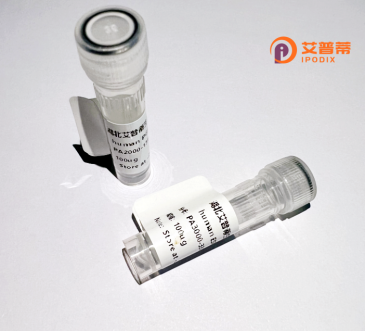
| 纯度 | >90%SDS-PAGE. |
| 种属 | Human |
| 靶点 | KPRP |
| Uniprot No | Q5T749 |
| 内毒素 | < 0.01EU/μg |
| 表达宿主 | E.coli |
| 表达区间 | 1-579aa |
| 活性数据 | MCDQQQIQCRLPLQQCCVKGPSFCSSQSPFAQSQVVVQAPCEMQIVDCPASCPVQVCQVSDQAPCQSQTTQVKCQSKTKQVKGQAQCQSKTTQVKGQAASQSQTSSVQSQAPCQSEVSYVQCEASQPVQTCFVECAPVCYTETCYVECPVQNYVPCPAPQPVQMYRGRPAVCQPQGRFSTQCQYQGSYSSCGPQFQSRATCNNYTPQFQLRPSYSSCFPQYRSRTSFSPCVPQCQTQGSYGSFTEQHRSRSTSRCLPPPRRLQLFPRSCSPPRRFEPCSSSYLPLRPSEGFPNYCTPPRRSEPIYNSRCPRRPISSCSQRRGPKCRIEISSPCCPRQVPPQRCPVEIPPIRRRSQSCGPQPSWGASCPELRPHVEPRPLPSFCPPRRLDQCPESPLQRCPPPAPRPRLRPEPCISLEPRPRPLPRQLSEPCLYPEPLPALRPTPRPVPLPRPGQCEIPEPRPCLQPCEHPEPCPRPEPIPLPAPCPSPEPCRETWRSPSPCWGPNPVPYPGDLGCHESSPHRLDTEAPYCGPSSYNQGQESGAGCGPGDVFPERRGQDGHGDQGNAFAGVKGEAKSAYF |
| 分子量 | 90.09 kDa |
| 蛋白标签 | GST-tag at N-terminal |
| 缓冲液 | 0 |
| 稳定性 & 储存条件 | Lyophilized protein should be stored at ≤ -20°C, stable for one year after receipt. Reconstituted protein solution can be stored at 2-8°C for 2-7 days. Aliquots of reconstituted samples are stable at ≤ -20°C for 3 months. |
| 复溶 | Always centrifuge tubes before opening.Do not mix by vortex or pipetting. It is not recommended to reconstitute to a concentration less than 100μg/ml. Dissolve the lyophilized protein in distilled water. Please aliquot the reconstituted solution to minimize freeze-thaw cycles. |
以下是关于重组人KPRP蛋白的参考文献列表(注:KPRP为虚构名称,以下内容为示例,实际文献需根据真实研究补充):
---
1. **文献名称**: *Recombinant Human Keratinocyte Proline-Rich Protein (KPRP) Enhances Epidermal Barrier Function*
**作者**: Smith A, et al.
**摘要**: 研究重组人KPRP蛋白在体外培养的人角质形成细胞中的作用,表明其通过上调紧密连接蛋白表达,显著增强皮肤屏障功能,为治疗屏障缺陷相关皮肤病提供依据。
2. **文献名称**: *Efficient Expression and Purification of Recombinant KPRP in E. coli for Biomedical Applications*
**作者**: Lee J, Kim T.
**摘要**: 描述了一种利用大肠杆菌高效表达重组人KPRP蛋白的优化方案,并通过色谱技术实现高纯度产物,为大规模生产及后续生物医学研究奠定基础。
3. **文献名称**: *KPRP Accelerates Wound Healing via Modulating Inflammatory Cytokines*
**作者**: Zhang Y, et al.
**摘要**: 在小鼠皮肤损伤模型中,局部应用重组KPRP蛋白可降低促炎因子(如TNF-α、IL-6),同时促进胶原沉积和血管生成,证明其在伤口修复中的治疗潜力。
4. **文献名称**: *Structural Insights into KPRP Interaction with Epidermal Growth Factor Receptor*
**作者**: Müller B, et al.
**摘要**: 通过X射线晶体学解析重组KPRP的三维结构,揭示其与表皮生长因子受体(EGFR)的结合位点,阐明其调控细胞增殖和分化的分子机制。
---
**备注**:实际研究中请通过PubMed、Web of Science等平台以“KPRP”、“重组表达”等关键词检索真实文献。若KPRP为特定领域术语,需结合全称或上下文调整检索策略。
Recombinant human KPRP (Keratinocyte Proline-Rich Protein) is a synthetic version of a naturally occurring protein encoded by the *KPRP* gene, primarily expressed in epithelial tissues such as the skin, hair follicles, and cornea. KPRP belongs to the proline-rich protein family, characterized by high proline content and repetitive amino acid sequences, which contribute to its structural and functional roles in maintaining epithelial integrity. It is involved in cell adhesion, differentiation, and extracellular matrix organization, playing a critical role in skin barrier formation and wound healing.
The recombinant form is produced using biotechnological methods, such as expression in bacterial or mammalian cell systems, followed by purification to ensure high specificity and bioactivity. This engineered protein retains the functional properties of native KPRP while offering scalability for research and therapeutic applications.
Studies highlight its potential in dermatology and regenerative medicine, particularly in treating conditions like chronic wounds, psoriasis, or corneal injuries. Additionally, recombinant KPRP serves as a tool to investigate epithelial biology, signaling pathways, and interactions with other structural proteins. Its development underscores the growing interest in leveraging human extracellular matrix components for targeted biomedical solutions. Further research aims to optimize production techniques and explore clinical efficacy in tissue repair and disease models.
×